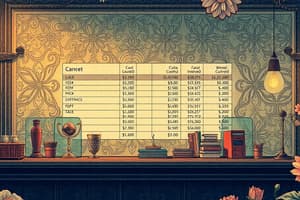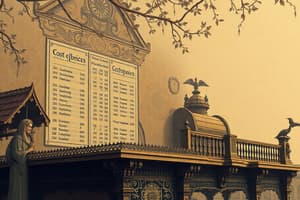Podcast
Questions and Answers
What is the expected increase in sales quantity?
What is the expected increase in sales quantity?
- 30%
- 10%
- 20% (correct)
- 40%
What is the expected increase in material prices?
What is the expected increase in material prices?
- 40%
- 30%
- 20%
- 10% (correct)
What is the amount of additional Advertisement Expenses incurred?
What is the amount of additional Advertisement Expenses incurred?
- ₹ 45,200 (correct)
- ₹ 75,320
- ₹ 54,240
- ₹ 65,280
If the initial output was 100 units, what is the expected output after the increase?
If the initial output was 100 units, what is the expected output after the increase?
If the initial material cost was ₹ 100, what is the expected material cost after the increase?
If the initial material cost was ₹ 100, what is the expected material cost after the increase?
What is the monthly production capacity of the plant?
What is the monthly production capacity of the plant?
If the company produces 10,000 units in a month, what would be the total raw material cost?
If the company produces 10,000 units in a month, what would be the total raw material cost?
Assuming that the company operates at full capacity, what is the total raw material cost for the entire year?
Assuming that the company operates at full capacity, what is the total raw material cost for the entire year?
If the company decides to purchase raw materials at a discounted rate of ₹18 per unit, what would be the total raw material cost for a production run of 10,000 units?
If the company decides to purchase raw materials at a discounted rate of ₹18 per unit, what would be the total raw material cost for a production run of 10,000 units?
What is the total cost of production for the year 2017?
What is the total cost of production for the year 2017?
What is the cost of goods sold for the year 2017?
What is the cost of goods sold for the year 2017?
What is the selling price per unit?
What is the selling price per unit?
What is the profit margin percentage?
What is the profit margin percentage?
If the selling expenses were increased by 10%, what would be the new profit margin percentage?
If the selling expenses were increased by 10%, what would be the new profit margin percentage?
What is the expected net return on the capital employed?
What is the expected net return on the capital employed?
What is the purpose of preparing a Cost Sheet?
What is the purpose of preparing a Cost Sheet?
What is the purpose of preparing a price statement?
What is the purpose of preparing a price statement?
What factors are considered when determining the selling price of a product or service?
What factors are considered when determining the selling price of a product or service?
What is the relationship between the net return on capital employed and the selling price?
What is the relationship between the net return on capital employed and the selling price?
If the Works Overheads for a unit are ₹ 1,000, what would be the Direct Labour cost for that unit?
If the Works Overheads for a unit are ₹ 1,000, what would be the Direct Labour cost for that unit?
If the Cost of Goods Sold per unit (excluding Administration Overheads) is ₹ 11,200, and the Direct Labour cost is ₹ 1,750, what is the Works Overheads cost for that unit?
If the Cost of Goods Sold per unit (excluding Administration Overheads) is ₹ 11,200, and the Direct Labour cost is ₹ 1,750, what is the Works Overheads cost for that unit?
What would be the total cost per unit, including Selling Expenses, but excluding Administration Overheads?
What would be the total cost per unit, including Selling Expenses, but excluding Administration Overheads?
If the Works Overheads for a unit are ₹ 1,000 and Direct materials cost is ₹ 5,000, what would be the total Cost of Goods Sold (excluding Administration Overheads) for that unit?
If the Works Overheads for a unit are ₹ 1,000 and Direct materials cost is ₹ 5,000, what would be the total Cost of Goods Sold (excluding Administration Overheads) for that unit?
If the Selling Expenses per unit were to increase to ₹ 900, and the Cost of Goods Sold per unit (excluding Administration Overheads) remains at ₹ 11,200, what would be the new total cost per unit, excluding Administration Overheads?
If the Selling Expenses per unit were to increase to ₹ 900, and the Cost of Goods Sold per unit (excluding Administration Overheads) remains at ₹ 11,200, what would be the new total cost per unit, excluding Administration Overheads?
What is the value of the opening inventory of raw materials?
What is the value of the opening inventory of raw materials?
What is the cost of goods sold (COGS) based on the information provided?
What is the cost of goods sold (COGS) based on the information provided?
What is the value of the total manufacturing overhead?
What is the value of the total manufacturing overhead?
What is the value of the total indirect expenses?
What is the value of the total indirect expenses?
What is the value of the cost of goods manufactured (COGM)?
What is the value of the cost of goods manufactured (COGM)?
What is the value of the direct material used in production?
What is the value of the direct material used in production?
What is the amount of gross profit based on the given financial data?
What is the amount of gross profit based on the given financial data?
What is the total value of the closing inventory?
What is the total value of the closing inventory?
Flashcards
Installed Capacity
Installed Capacity
The total production ability of a plant, measured annually.
Monthly Distribution
Monthly Distribution
The capacity of the plant spread evenly across each month.
Cost Structure
Cost Structure
The breakdown of costs involved in production of a product.
Raw Material Cost
Raw Material Cost
Signup and view all the flashcards
Unit Production Cost
Unit Production Cost
Signup and view all the flashcards
Advertisement Expenses
Advertisement Expenses
Signup and view all the flashcards
Sales Growth Percentage
Sales Growth Percentage
Signup and view all the flashcards
Material Price Increase
Material Price Increase
Signup and view all the flashcards
Cost-Benefit of Advertising
Cost-Benefit of Advertising
Signup and view all the flashcards
Impact of Advertising
Impact of Advertising
Signup and view all the flashcards
Total Production
Total Production
Signup and view all the flashcards
Total Costs
Total Costs
Signup and view all the flashcards
Selling Price Calculation
Selling Price Calculation
Signup and view all the flashcards
Factory Overheads
Factory Overheads
Signup and view all the flashcards
Rate of Profit
Rate of Profit
Signup and view all the flashcards
Direct Labour
Direct Labour
Signup and view all the flashcards
Works Overheads
Works Overheads
Signup and view all the flashcards
Cost of Goods Sold
Cost of Goods Sold
Signup and view all the flashcards
Selling Expenses
Selling Expenses
Signup and view all the flashcards
Excluding Administration Overheads
Excluding Administration Overheads
Signup and view all the flashcards
Net Return
Net Return
Signup and view all the flashcards
Capital Employed
Capital Employed
Signup and view all the flashcards
Cost Sheet
Cost Sheet
Signup and view all the flashcards
Price Statement
Price Statement
Signup and view all the flashcards
Expected Profit Margin
Expected Profit Margin
Signup and view all the flashcards
Inventories
Inventories
Signup and view all the flashcards
Raw Material
Raw Material
Signup and view all the flashcards
WIP (Work in Progress)
WIP (Work in Progress)
Signup and view all the flashcards
Closing Inventories
Closing Inventories
Signup and view all the flashcards
Sales Returns
Sales Returns
Signup and view all the flashcards
Factory Expenses
Factory Expenses
Signup and view all the flashcards
Sales Commission
Sales Commission
Signup and view all the flashcards
Study Notes
Cost Sheet
- A cost sheet is a statement outlining the various subdivisions of costs, illustrating the breakdown of costs according to their nature, relation to cost centers, and relation to functions.
- Subdivisions of costs include material, labor, and expense.
- Cost sheet classifications include direct and indirect costs, as well as those related to production, goods sold, and sales.
Items Excluded from Cost Sheet
- Items not included on a cost sheet can include write-offs, such as goodwill or preliminary costs; provisions, including those for income tax; and financial income or expense not directly related to sales.
- Disputed items, such as audit fees, statutory audit fees, and bad debts, have different treatment.
Valuation of Inventory
- Inventory valuation can be done using various methods, depending on the specific inventory requirements.
- These methods may vary for different inventory types.
Cost Sheet Format and Classification
- Cost sheets have a specific format for classifying costs, which varies across industries and organizations.
- A cost sheet often classifies costs into different categories based on whether they are direct or indirect, and whether they pertain to production, sales, or administration.
Effect of Semi-Variable Overhead
- Semi-variable overheads have an impact on cost sheets, often influencing the total cost of production.
- The effect is specific to each cost sheet.
Multiple Products
- Cost methods for multiple products vary but are essential for calculating costs for different product types on a cost sheet.
Treatment of Defectives
- Defects in production can affect the valuation of inventory and related costs on a cost sheet, and how these costs are handled and accounted for will vary.
Studying That Suits You
Use AI to generate personalized quizzes and flashcards to suit your learning preferences.




